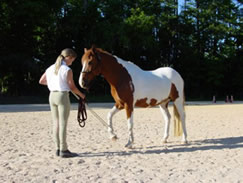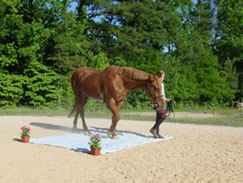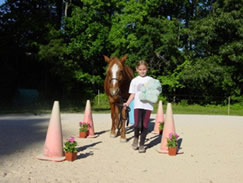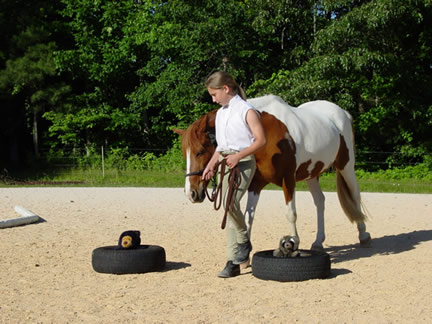Written by Sylvana Smith
For her 12th birthday a few years ago, a young friend received the gift of which most little girls dream: a dainty, pretty 15-hand filly. Her non-horsey mother had chosen the green-broke 3-year-old as the perfect gift because the filly “had the prettiest little face.” I might deem other qualities more important in choosing a mount for a timid novice rider, but the birthday horse was a surprise to all of us, including the girl’s father.
On birthday presentation day, with all gathered members of the boarding barn watching, the birthday filly stuck that pretty little face between her knees and launched the birthday girl off in short order. An adult got on the filly to set things straight. The birthday filly “had a pure fit,” and then slung her pretty little face around so hard she broke her rider’s nose.
The girl’s mother, whose disappointment was exceeded only by her naiveté about green equines, insisted that the girl and the filly were “made for each other,” and all would be well once they had “some time to bond,” as long as the birthday girl would just “get right back up on that horse and show it who’s boss,” which the birthday girl refused to do.
Hearing about that incident, I reflected on the wonderful, effective groundwork exercises we do to soften our horses in typical colt-starting clinics, and how they could help the hapless birthday pair. So I translated those exercises into “games you can play to make your pony your best friend.” Anthropomorphic? Sure. Frivolous? Sure. Trivializing the serious importance of groundwork? Sure. But this was a kid, and I believed we’d have more success capitalizing on kid-sized motivations and language than on high-browed explanations of systematic training continuums.
Adults can be persuaded to school their horses purely for the pleasure of improving their horses and themselves. Kids might need a little more than that altruistic motivation, and my young friend was no exception. She wanted a Western Pleasure ribbon-winner, not a training project-and she needed help finding hope in her present fear and suspicion. So I packaged up helpful groundwork exercises into a fun series of interactive games designed for kid-appeal. The exercises will look familiar, but the explanations surely won’t.
Here are some creative ideas for translating serious groundwork into productive fun for children and their ponies. These ideas are really just a starting point. You can apply the same kid-translation concepts to recast any horsemanship exercise into a child-oriented activity.
The games below sketch out possible scenarios and kid-style explanations in first-person style, to help children visualize themselves in action. These instructions are not intended to be a replacement for adult instruction. Naturally, children will need guidance from knowledgeable adults as they follow these highly simplified descriptions. So, with a suitable pony and adult instruction at hand, here are some idea-starters.
Ground games: The Building Blocks

Watch Me. I turn my pony loose in the round pen, with no halter or bridle on. She gets a few minutes to play around and check things out before we get started. Then, when she’s running around and watching other things, I step toward her and wave my hands or my rope. When she tips one ear back or tips her head to look at me, I step backwards a few steps to draw her in. If I’m careful moving toward her and waving when she’s looking away, and backing up when she’s looking at me, soon she knows I’m inviting her to come and look at me and be quiet. She turns her rump to the fence, faces me, and makes puppy-dog eyes at me. I can do this in both directions.
Magnet Pony. When we can do the Watch Me game, I can draw my pony to me with no lead line, like magic. When I step a little to one side, she takes a sideways step so she can keep facing me. I can take another step, and stand quietly, and she’ll take another sideways step to face me. We are just like two magnets, drawn to each other. We can do this in both directions.
Invisible Leash. When we can do the Magnet Pony game, I can walk my pony all over the round pen like a dog with an invisible leash. I won’t walk so fast that she can’t keep up, or we’ll lose the magnet connection. But if I give her time to figure out where I’m going, she follows me even if I walk wiggly lines or circles. I rub and pet her for being so good.
Invisible Pony Cart. When we can do the Invisible Leash game, my pony and I can pretend to drive around the round pen with my invisible pony cart. As she walks around the round pen, I am several steps behind her and to one side (not where I could be kicked), holding the invisible driving reins in my hands. I can point or wag a finger at her eye to “push” her away from me, or step in behind her to “pull” her toward me. We can drive in either direction around the edge of the round pen, or in figure-eights that cross through the middle.
Swivel Pony. (With halter and 10-foot lead.) When I gently bring my pony’s head toward me and step toward her rump, she swivels her rump away from me smoothly. I can do this for one step or several steps in either direction.
Back ‘n forth. With a fingertip touch on the halter (more if she has sticky feet), I can get my pony to back up one step. When she starts to lift a foot to back up, I don’t tug any more. One step at a time-touch-release-touch-release-I can get her to back up five steps or 10 steps, as many as I want. Then, with just a fingertip tug on the halter, I can get her to step forward again into the walk. If she has sticky feet that seem glued to the ground, or if she flips up her head, we’ll just keep working at this until it is smooth.
Bendable-Poseable Barbie’s Dream Horse. I can bend my pony’s head toward me softly with a light touch on the halter or with my fingers over her nose, tugging her gently toward me and releasing. She does this softly without leaning on my hands. I can cuddle her with soft wriggly fingers behind her ears, to get her to melt with her head lower and lower, almost to the ground. With a light touch of my fingers on her face, I can tip her muzzle an inch or two closer to her chest.
Carousel Pony. My pony can walk around me on the end of the halter rope like a steady merry-go-round pony while I stand in the middle. If the merry-go-round slows down, I can wave it to go a little faster. If the merry-go-round goes too fast, I can move a little toward the carousel pony’s face, or just think “slow” and wait for it to slow down. Unlike a merry-go-round, we can do this in both directions.
Walking the Dog. Since we’re so good at Swivel Pony, Back ‘n Forth, and Carousel Pony, now I can walk the pony all around just like walking a toy poodle on a leash made of thread. She weighs nothing on the end of the poodle leash, and follows me wherever I go, without tugging or pulling ahead.

Puppet Horse. I can wrap a soft beach towel, polo wrap, or lead rope behind my pony’s pastern (right above the hoof), gently pick up a front foot, stretch it forward a bit, and place it down a few inches in front of where it was. My marionette pony and I can do this with all four feet, one foot at a time. Sometimes I help her a bit by showing her how to put her weight on the other foot so she can lift this one. That’s okay because it keeps getting better.
Laundry Line. My pony will stand quietly while she pretends to be a laundry line, with me rubbing her with a bright towel, dark towel, paper feed sack, shirt, saddle pad, and rain slicker -then casually flapping these things near her, then brushing against her legs with these things.
Snake Walk. My pony walks softly on a loose lead through a serpentine pattern set up with cones, yielding away from me on the right-hand turns just from a visual cue from my left hand, or by following me as I walk out in front.
Long Way Back. I can back my pony softly on the halter rope from one marked spot to between a set of cones about 20 steps back. I ask gently, then release the pressure at each step she gives me. She backs willingly and mostly straight, with her head down and soft.
Stepping Stones. I can walk my pony through a set of jump poles set up in a straight line and on a circle pattern like spokes of a wheel. She lowers her head to look at the poles. I can walk her calmly through an “L” chute laid out in poles, and across a plastic tarp spread out on the ground.
Swivel Pony Plus. When I press my fingers lightly on her flank and bring her head slightly toward me, my pony will swivel her rump away from me while her front feet stay in place. With a little wriggling touch on her shoulder and neck, I can have my pony step her front feet away from me while her back feet stay pretty much in place. When she does this without tensing up and
pushing back at me, I rub and pet her for being so good.
Side-stepper. I can put the Swivel Pony Plus moves together and have my pony move sideways away from me when I press, like a gentle nudge-nudge, on her middle with my fingers. If one end gets stuck, I move my presses toward where she’s stuck to even things out.
Ground games: Putting Building Blocks Together
With these foundations in place, perhaps in a second or third session, adult instructors can combine these basic ground games into obstacle courses and simple non-competitive games. Capitalize on props, imagination, popular culture, and familiar games to make the groundwork lively. I’d stay away from piñata-inspired games and Pin the Tail on the Donkey, but a lot of other popular games are fair play.
Simon Says
Adults: Organize a set of index cards with your instructions so you can move the game along fairly quickly with funny and diverse ideas.
Pony-pals: Do what Simon Says! “Simon says, ‘Back your pony two steps.'” “Make your pony waggle its ears.” “Simon says, ‘Swivel the pony’s rump over two steps.'” “Simon says, ‘Walk forward 10 steps.'” “Tell your pony he looks like Shrek’s donkey.” “Simon says, ‘Melt your pony until his ears are lower than yours.'” “Make your pony whinny a Britney Spears song.” “Simon says, ‘Turn completely around with your poodle-pony without tugging on the leash.'”

Hopscotch
Adults: Define a simplified hopscotch board in the arena with lime or jump poles and decide on an action for each square.
Pony-pals: Make your way through the board and do the hopscotch steps. For example, in square 1, turn a circle to the left. Step into square 2 and turn a circle to the right. In square 3, back up two steps. In square 4, stand still. In square 5, bend the pony’s face to the left and right. In square 6, melt the pony ‘til his muzzle is beside your waist. Hop on out!
Clue
Adults: Stretch your imagination to come up with a theme for an arena ‘adventure’ that uses everyday props in new ways.
Pony-pals: Use the ground game skills you and your pony have gained to follow the adventure, clue by clue. For example: Walk the poodle-pony on the invisible leash as you wind your way through the boulder field (puffed-up feed sacks, weighted with bricks). Follow the directions written on the last boulder, which tell you to weave your way through the troll forest (upside-down Strongid buckets with house-plants on top). Follow the directions there, which tell you to splash across the lake (blue tarp). Reach into the witch’s cauldron (muck bucket) to pull out the last clue, attached to a slug (Tootsie Roll), and so on.
Chutes and Ladders
Adults: Set out a Chutes and Ladders course in three or four rows, with one chute, one ladder, and three safe zones per row (more safe zones and ladders for very young kids). Use cardboard cutouts taped to buckets or stuck in the sand to number the stations/squares. Chutes are made of jump poles a few feet apart, perhaps getting narrower as they go, perhaps using four or six poles to turn corners. Ladders are jump poles set up as cavaletti.
Pony-pals: Roll the dice or spin the spinner to see how many stations you move. Without tugging on the lead rope, lead your pony through the chutes and across the ladders until you get to your square. If you land on a chute, slide down to the next level. If you land on a ladder, climb up to the next level. If you land on a safe zone, take another spin. If you can back your pony up a chute without touching the rails or stepping out of the chute, you can come back up to where you were.
Bunny Rescue
Adults: Set out orange cones, all shapes and sizes, into an impromptu carrot patch, and place the stuffed bunny on a barrel at the other end.
Pony-pals: Follow the instructions on each carrot to get to the bunny. For instance, you might have to circle left around one carrot, circle right around another carrot, trot to the next carrot, or back up from one carrot to another, one step at a time. When you reach the bunny, grab it and trot back to the start line without tugging on your rescue pony.
Tips for Fun and Success

For adults setting up horsemanship games for kids, here are some guidelines to help make the most of the activities.
DO consider creative and off-beat ways to translate exercises from serious horsemanship jargon into kid-ese. I freely use comical names-such as Puppet Horse and Bendable-Poseable Barbie’s Dream Horse- and non-PC terms, such as swish, cuddle, melt, wriggle, squiggle, and puppy-dog eyes.
DO tailor your language to suit the age group you’re working with. For example, I might tend toward Disney and Sesame Street metaphors with little ‘uns, fairytale and circus images and board games with the 8-10 set, popular culture icons and examples with the pre-teen set, and casual language without condescension (no “puppy-dog eyes,” for example) when working with teens.
DO be creative with props, points, prizes, and such to add fun to the exercises… such as stuffed animals to rescue, paper cut-out prizes to fetch and redeem for carrots, painted cardboard trees stapled to jump standards to create an enchanted forest, and blue-plastic tarp “lakes” to ford.
DO capitalize on children’s power of make-believe to turn everyday objects into more than they are, and everyday activities into something fantastical. Poles on the ground can be train tracks, a ladder, a four-square court, or a wiggly mountain trail. Tires can be critter burrows with stuffed animals from the thrift shop peeking out of them. Water buckets filled to the brim and placed around the arena can be magic mirror pools. Lines drawn in the sand with lime, or mown into a field, can define a maze to navigate.
DO capitalize on current popular culture to keep things interesting. Perhaps “hooking on” is helped along with some make-believe Harry Potter-type magic. Perhaps basic halter-rope work is done by Spiderman with a spiderweb-light connection that would be easily broken with a harsh tug. Perhaps Shrek can help kids understand that pony behavior that seems ogre-like actually comes from being misunderstood.
DO consider ways to combine exercises into game-like activities. As you saw from the earlier examples, the kids rescue stuffed animals, play Simon Says, weave through the carrot patch, escape through a maze, and such, all while building on basic groundwork skills.
DON’T set up competitive game situations, because the quest to win the game will erode good horsemanship.
DO keep sessions short, to suit the age and attention span of your kids on that particular day. Even when veneered in make-believe and fun, groundwork can get old after a while.
DON’T use skittish, unreliable, or green horses to play these ground games. These activities are really about teaching technique and awareness to the kids, not about schooling the ponies.
DO consider safety in all things, so in addition to matching temperaments, try to size-match kids and equines if you can. It’s hardly fair for a 4-foot-tall child to do groundwork with a 16.2-hand horse, however placid the big guy might be.
Closing Thoughts
I remember well what it was like to be a horse-crazy 10-year-old, a naive 11-year-old, an intrepid yet unpolished 12-year-old, a zealous and often selfish 13-year-old, and a ribbon-hungry, trail-blazin’ 14-year-old.
Was I motivated by a self-actualizing drive to reach pinnacles of classical horsemanship? Uh, nope. I wanted fun, thrills, ribbons, good times, and peer-group acceptance. Good horsemanship might help me get all those things, but conceptual ideals of precision and partnership were certainly secondary.
While we might wish our young students to be motivated by pure ideals and self-improvement, that’s not necessarily realistic. There’s no harm in gift-wrapping valuable lessons in ways that make them more meaningful on a child’s level.
The 12-year-old in my story started her first ground-games day full of fearful disdain for the filly that seemed to dislike her so much-and ended up the hour-long session beaming with joy because her new horse would follow her all over the paddock on an invisible leash. It marked the beginning of a new relationship between them, and maybe the beginning of a new perspective for her on horses in general.
Maybe this young rider would have been receptive to serious groundwork on the grounds of self-preservation alone, but I do think we gain more acceptance and participation among the young set by disguising serious work as not-so-serious fun ‘n games.


